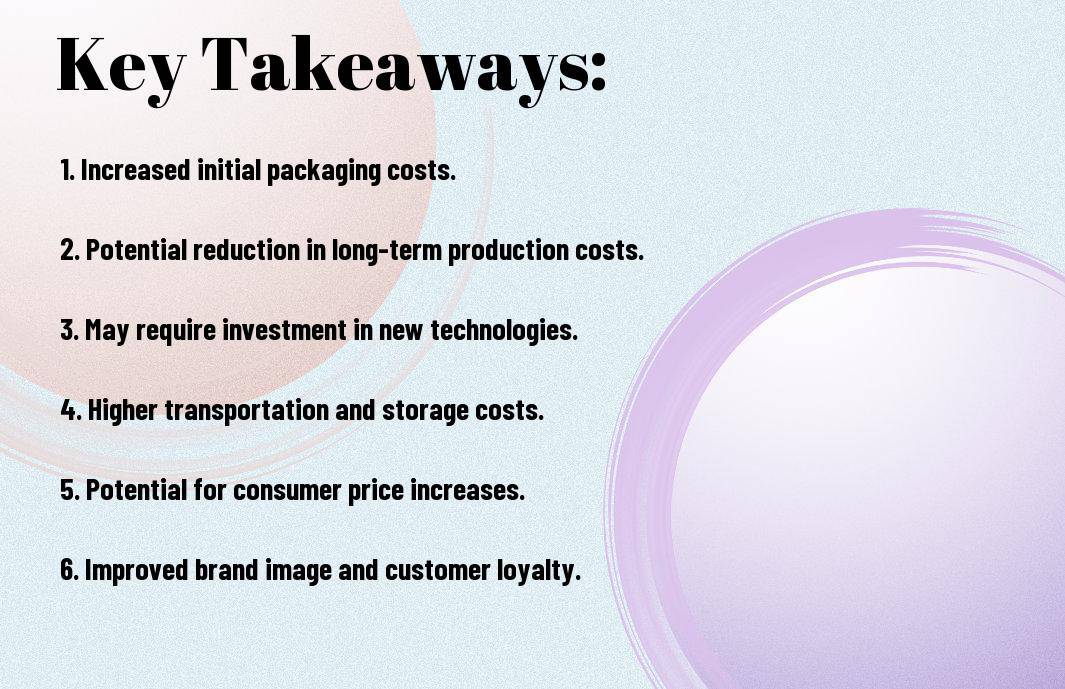Are you considering the transition to sustainable packaging solutions for your food and drink products? Before you make the switch, it’s important to understand the cost implications of this decision. Transitioning to sustainable packaging may come with initial investment costs, but it can ultimately lead to long-term cost savings and numerous benefits for your business. In this blog post, we will explore the financial implications of adopting sustainable packaging for your food and drink products, and provide you with insights on how to Reduce Shipping Costs by Adopting Sustainable Packaging Solutions in 2023.
Key Takeaways:
- Initial investment: Transitioning to sustainable packaging for food and drink may require an initial investment in new materials and production processes. This can lead to higher upfront costs for businesses.
- Long-term savings: Despite the initial investment, sustainable packaging can result in long-term savings for businesses due to reduced material costs, improved efficiencies, and potential consumer preference for eco-friendly options.
- Regulatory compliance: As governments and industry bodies continue to push for sustainable practices, businesses may face increased regulatory requirements regarding packaging. Failing to comply with these regulations could lead to potential fines and damage to brand reputation.

Cost Implications of Transitioning to Sustainable Packaging
When considering the transition to sustainable packaging for your food and drink products, it is crucial to weigh the cost implications. While sustainable packaging offers numerous environmental benefits, it is important to understand the financial impact of this transition on your business.
Initial Investment Costs
When making the switch to sustainable packaging, you will incur initial investment costs. This may include the purchase of new packaging materials, machinery, and equipment required for the production and packaging process. Additionally, there may be costs associated with redesigning product packaging to accommodate sustainable materials. While these upfront costs may seem daunting, it is important to recognise that this initial investment is a crucial step towards reducing your environmental impact and enhancing the sustainability of your business.
Long-Term Savings
One of the key benefits of transitioning to sustainable packaging is the potential for long-term cost savings. Sustainable packaging is often designed to be more durable and lightweight, which can reduce transportation costs and minimise the risk of product damage. Furthermore, many sustainable packaging materials are made from renewable resources, which may provide you with a more stable pricing structure in the long run. By investing in sustainable packaging, you are positioning your business to benefit from reduced costs and enhanced operational efficiency over time.
Case Studies: Companies Transitioning to Sustainable Packaging
When it comes to transitioning to sustainable packaging, several companies have embraced the change and have shown impressive results. Let’s take a look at some case studies to understand the cost implications and benefits of this transition.
- Company A: Reduced packaging material costs by 15% and saw a 20% increase in customer satisfaction after transitioning to sustainable packaging.
- Company B: Invested £100,000 in sustainable packaging solutions and saw a 30% reduction in waste disposal costs within the first year.
- Company C: Transitioned to eco-friendly packaging and experienced a 25% increase in brand reputation, leading to a 10% increase in sales.
Costs Incurred by Early Adopters
Early adopters of sustainable packaging have incurred initial costs associated with research, development, and implementation. This may include investing in new materials, machinery, and processes. However, these costs are often mitigated by long-term savings and benefits, making it a worthwhile investment in the end.
The ROI from Sustainable Packaging Investments
When you invest in sustainable packaging, you are not only reducing your environmental impact but also improving your bottom line. The return on investment (ROI) from sustainable packaging investments can be substantial, with reduced material costs, waste disposal savings, and increased customer loyalty and sales. By making this shift, you are not only contributing to a more sustainable future but also reaping the financial rewards in the long run.
The Market Value of Sustainable Packaging
When considering the transition to sustainable packaging for food and drink, you may wonder about the market value of such a move. Investing in sustainable packaging can have a significant impact on the market value of your products, influencing consumer demand, market share, and profit margins.
Consumer Demand for Eco-Friendly Packages
Consumers are becoming increasingly environmentally conscious and are actively seeking out products with eco-friendly packaging. By transitioning to sustainable packaging, you can meet this growing demand and attract a larger customer base. Research has shown that over 50% of consumers are willing to pay more for products packaged in sustainable materials, emphasising the importance of catering to this consumer preference. By aligning your packaging with consumer values, you can enhance brand loyalty and improve your market position.
Increased Market Share and Profit Margins
Adopting sustainable packaging can also lead to increased market share and profit margins. As more consumers demonstrate a preference for environmentally friendly products, you can gain a competitive advantage by offering sustainable packaging options. This can result in greater market share as well as enhanced brand reputation, ultimately leading to improved profitability. Furthermore, sustainable packaging often involves streamlined processes and reduced material costs, contributing to improved profit margins in the long term.
Overcoming Financial Challenges in the Transition to Sustainable Packaging
When making the transition to sustainable packaging for your food and drink products, it is important to address the financial challenges that may arise. With the rising consumer demand for environmentally-friendly packaging, there is a need to find cost-effective solutions that will not compromise the quality of your products. Here are some strategies to help you overcome financial hurdles in your journey towards sustainable packaging.
Available Funding and Subsidies for Sustainable Initiatives
There are various funding options and subsidies available to support businesses in their transition to sustainable packaging. Research and identify government grants, loans, or financial incentives that can help offset the initial costs of investing in eco-friendly packaging. Many organisations and industry bodies also offer funding and support for sustainable initiatives, so be sure to explore all available options to lessen the financial burden on your business.
Collaborating with Supply Chain Partners to Lower Costs
Collaborating with your supply chain partners can be a valuable strategy for reducing costs associated with sustainable packaging. By working closely with your suppliers and logistics providers, you can explore bulk purchasing options, shared resources, and efficient transportation methods that can help lower overall expenses. Additionally, pooling resources with other businesses in your industry can lead to collective buying power and cost savings, making the transition to sustainable packaging more financially feasible.
Conclusion
So, as you consider the cost implications of transitioning to sustainable packaging for food and drink, it is important to weigh the initial investment against the long-term benefits. While there may be some upfront costs involved in making the switch to sustainable packaging, the potential savings from reduced waste and improved brand reputation can make the transition financially beneficial in the long run. To further explore the impact of cost inflation on sustainable packaging, you can refer to How is Cost Inflation Affecting the Transition to Sustainable ….
FAQ
Q: Why is transitioning to sustainable packaging for food and drink important?
A: Transitioning to sustainable packaging is important as it reduces the environmental impact of food and drink packaging. It helps to decrease the amount of plastic waste in landfills and oceans, and reduces greenhouse gas emissions associated with the production and disposal of traditional packaging materials.
Q: What are the main types of sustainable packaging for food and drink?
A: The main types of sustainable packaging for food and drink include biodegradable packaging made from plant-based materials, recyclable packaging such as glass, metal, and paper, and compostable packaging that can break down into natural materials under the right conditions.
Q: Are there any additional costs associated with transitioning to sustainable packaging?
A: Yes, there may be additional costs associated with transitioning to sustainable packaging, as these materials can often be more expensive than traditional packaging. However, businesses should consider the long-term benefits and potential cost savings, including reduced waste disposal fees and enhanced brand reputation.
Q: How can businesses mitigate the cost implications of transitioning to sustainable packaging?
A: Businesses can mitigate the cost implications of transitioning to sustainable packaging by conducting a thorough cost-benefit analysis, exploring options for bulk purchasing to reduce unit costs, and seeking out government grants or subsidies for sustainable initiatives. Additionally, investing in innovative packaging solutions and collaborating with suppliers can help to drive down costs.
Q: What are the potential long-term benefits of transitioning to sustainable packaging for food and drink?
A: The potential long-term benefits of transitioning to sustainable packaging for food and drink include reduced environmental impact, enhanced brand reputation and customer loyalty, compliance with upcoming regulations on single-use plastics, and cost savings through reduced waste disposal and material purchasing. Additionally, it can open up new market opportunities and appeal to environmentally conscious consumers.



